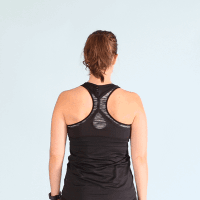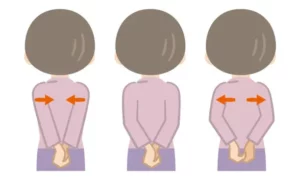Pain in the shoulder blades, also known as the scapulae, can be a quite discomforting and sometimes debilitating issue. It can range from a dull ache to sharp, stabbing pain, and it often interferes with daily activities. In this blog, we will delve into the world of shoulder scapula pain, exploring its potential causes, symptoms, diagnosis, and effective management strategies.
Contents
Understanding The Source Of Shoulder Scapula Pain
Understanding the causes of shoulder scapula pain is the first step in effectively addressing and alleviating this persistent ache.
- Muscle Strain and Overuse: One of the most common culprits behind shoulder scapula pain is muscle strain and overuse. Additionally, Maintaining incorrect posture, particularly slouching or hunching forward, places added stress on the muscles between the shoulder blades.
- Nerve Compression: Shoulder scapula pain can also be linked to nerve compression. Conditions that compress nerves in the neck or upper back, such as thoracic outlet syndrome or cervical herniated discs, can result in referred pain felt in the scapula area.
- Joint Problems: Issues with the shoulder joints can contribute to scapula pain. Problems with the acromioclavicular (AC) joint, located at the top of the shoulder, can cause discomfort that radiates to the scapulae. Dysfunction in the main shoulder joint, known as the glenohumeral joint, may lead to scapular pain as well.
- Referred Pain: Sometimes, the source of scapula pain isn’t directly related to the shoulder or upper back. Instead, it can be a form of referred pain from other areas of the body such as the neck. Gallbladder problems or digestive disorders like heartburn can also cause referred pain to the scapulae.
- Post-Traumatic Injury: A history of trauma or injury to the shoulder or upper back can lead to chronic scapula pain, even after the initial injury has healed. Scar tissue or residual damage can be sources of ongoing discomfort.
- Other Medical Conditions: In some cases, underlying medical conditions like fibromyalgia or myofascial pain syndrome can manifest as shoulder scapula pain.
- Lifestyle Factors: Certain lifestyle factors, including stress, obesity, or a sedentary lifestyle, can exacerbate scapula pain or contribute to its development.
Exercises For Relieving Shoulder Scapula Pain
Exercise plays a vital role in relieving and preventing shoulder scapula pain. So, here are some effective exercises for relieving shoulder scapula pain:
Shoulder Blade Squeezes
- How to Do It:
- Sit or stand up straight with your arms at your sides.
- Squeeze your shoulder blades together as if you’re trying to hold a pencil between them.
- Hold the squeeze for 5-10 seconds, then relax.
- Repeat this 10-15 times for 2-3 sets.
- Benefits: Shoulder blade squeezes help improve posture and strengthen the muscles between the shoulder blades, reducing tension and pain.
Thoracic Extension Stretch
- How to Do It:
- Sit on the edge of a chair with your feet flat on the floor.
- Place your hands behind your head, interlocking your fingers.
- Gently arch your upper back, pushing your chest forward while looking up toward the ceiling.
- Hold this stretch for 10-15 seconds, feeling a stretch in your upper back.
- Return to the starting position and repeat 5-10 times.
- Benefits: This stretch helps counteract forward-leaning postures, improving thoracic mobility and reducing scapula pain.
Scapular Retraction Exercise
- How to Do It:
- Sit or stand up straight with your arms at your sides.
- Keep your shoulders relaxed and slightly down.
- Slowly squeeze your shoulder blades together as if trying to pinch something between them.
- Hold for 5-10 seconds, then release.
- Repeat 10-15 times for 2-3 sets.
- Benefits: Scapular retraction exercises strengthen the muscles that stabilize and support the shoulder blades, promoting better posture and reducing pain.
Neck Stretches
- Neck stretches can also be beneficial if neck tension contributes to your scapula pain. Gently tilting your head from side to side and forward and backward can help relieve neck and shoulder tension.
Wall Angels
- How to Do It:
- Stand with your back against a wall, feet about shoulder-width apart.
- Raise your arms to shoulder height, bending your elbows at a 90-degree angle.
- Slowly slide your arms up the wall as high as you can, keeping your elbows and wrists in contact with the wall.
- Hold for a moment, then return your arms to the starting position.
- Repeat 10-15 times for 2-3 sets.
- Benefits: Wall angels help improve shoulder mobility, strengthen the shoulder and scapular muscles, and promote better posture.
Always perform these exercises slowly and gently, avoiding any movements that cause pain or discomfort. If you experience increased pain during or after exercising, stop the activity and consult with a healthcare provider or physical therapist.
Medical Treatments For Relieving Shoulder Scapula Pain
When shoulder scapula pain becomes persistent or severe, medical treatments may be necessary to address the underlying causes and provide effective relief. Here are some medical treatments commonly used to relieve shoulder scapula pain:
- Physical Therapy: Physical therapy is a crucial component of scapula pain management. A physical therapist can design a personalized exercise program to improve shoulder mobility, strengthen supporting muscles, and correct posture. Therapists may also use modalities such as ultrasound or electrical stimulation to reduce pain and inflammation.
- Medications: Depending on the cause and severity of your scapula pain, your healthcare provider may prescribe medications such as Nonsteroidal Anti-Inflammatory Drugs (NSAIDs), these drugs can help reduce pain and inflammation. If muscle spasms are contributing to your pain, your doctor may prescribe muscle relaxants. Prescription pain medications may be recommended for severe pain, but their use is typically limited due to the risk of dependency.
- Injections: In some cases, injections may be used to provide localized relief. Corticosteroid injections can reduce inflammation and provide pain relief when administered directly into the affected area. When muscle knots or trigger points contribute to scapula pain, injecting a local anesthetic into these points can alleviate discomfort.
- Nerve Blocks: For individuals with nerve-related scapula pain, nerve blocks may be considered. These involve injecting anesthetic agents near the affected nerves to block pain signals temporarily.
- Manual Therapy: Manual therapy techniques, such as joint mobilization or manipulation, can be performed by trained healthcare providers to improve joint and muscle function.
- Surgical Interventions: Surgery is typically considered when other treatments have failed, or if there’s an underlying structural issue that requires correction. Surgical options may include shoulder arthroscopy or AC joint surgery
- Bracing and Supports: Orthopedic braces or supports may be recommended to provide stability and relieve pressure on the affected area.
Effective Home Remedies For Shoulder Scapula Pain
Dealing with shoulder scapula pain can be a real challenge, but there are several home remedies and self-care techniques that you can explore to help alleviate discomfort and promote healing. Here are some effective home remedies for managing shoulder scapula pain:
- Rest and Avoid Aggravating Activities: The first step in managing scapula pain is to rest and avoid activities that exacerbate the pain. Overuse or repetitive movements can strain the muscles and aggravate the condition.
- Heat and Cold Therapy: Applying heat or cold packs to the affected area can provide relief. Use a heating pad or warm towel for 15-20 minutes to relax tense muscles. Alternatively, cold packs can reduce inflammation and numb the area.
- Posture Correction: Maintaining good posture is crucial for preventing and alleviating scapula pain. Ensure your workspace is ergonomically designed to promote proper posture and be mindful of your posture during daily activities.
- Over-the-Counter Pain Relievers: Non-prescription pain relievers like ibuprofen or acetaminophen can help reduce pain and inflammation. Follow the recommended dosage instructions and consult a healthcare provider if you have any concerns.
- Self-Massage: Gently massage the affected area to alleviate muscle tension. You can use your hand or a massage ball to apply gentle pressure. Be cautious not to apply too much pressure, especially if you’re experiencing acute pain.
- Anti-Inflammatory Diet: Consuming foods with anti-inflammatory properties can help reduce inflammation and pain. Include foods rich in omega-3 fatty acids (e.g., salmon, walnuts), fruits, vegetables, and whole grains in your diet.
- Stress Reduction Techniques: High-stress levels can exacerbate muscle tension and pain. Practicing stress-reduction techniques such as deep breathing exercises, meditation, or yoga can be beneficial.
- Proper Sleep and Mattress Support: Ensure you get enough quality sleep and consider using a supportive mattress and pillows to maintain good spinal alignment during sleep.
Conclusion
In conclusion, if you’re dealing with shoulder scapula pain, there are practical steps you can take to find relief. Begin by consulting a healthcare professional to pinpoint the cause and receive proper guidance. From there, consistent exercises, maintaining good posture, and practicing self-care techniques like heat and cold therapy can all contribute to reducing discomfort.
While it may take time and effort, the goal of living free from shoulder scapula pain is achievable. By following these steps and staying committed to your well-being, you can regain comfort and mobility in your daily life.
If you’re experiencing Shoulder pain, physical therapy for shoulder pain at PhysioMantra can help: Book an online physical therapy session.









